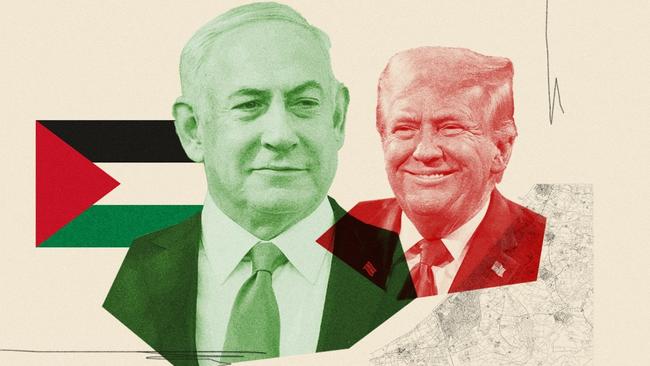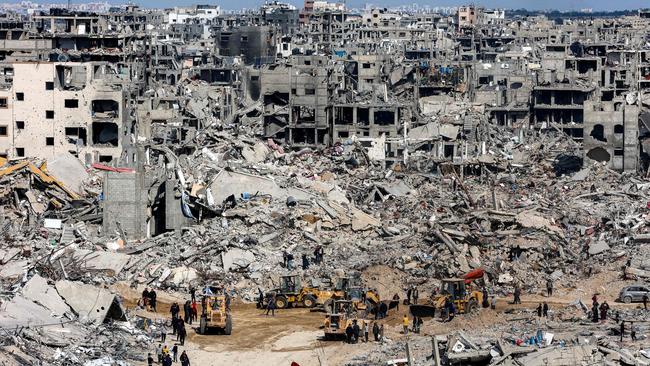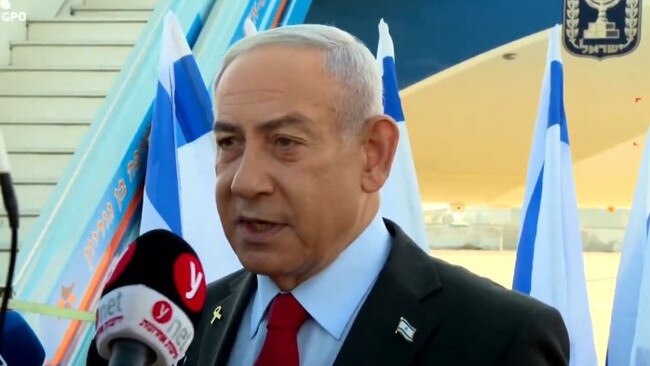Can Trump and Netanyahu make up? Gaza’s fate depends on it
Donald Trump and Benjamin Netanyahu don’t like or trust each other but the future shape not just of Gaza, but of the Middle East, may hang on their meeting this week.

Such is the importance of this relationship that Netanyahu will be the first foreign leader granted an Oval Office meeting since the president’s inauguration, even though the relationship between the two men is hardly cordial.
“Trump and Netanyahu do not like one another and do not trust one another, but they really do need each other,” notes Aaron David Miller, who worked on the Middle East peace process for much of his 24 years in the US State Department and now works for the Carnegie Endowment for International Peace.
Trump wants the Gaza ceasefire to move on from its first phase into a long-term cessation of violence, opening the pathway to a strategic deal with Saudi Arabia and the containment of Iran’s nuclear program.
For the Israeli prime minister, his priority is holding on to power while denying Hamas a victory in Gaza and keeping far-right coalition partners onside.
Many question, however, how he can do those things if he gives Trump what he wants on the ceasefire.

These issues will come to a head on the day of their meeting, when the timetable of the deal with Hamas requires Netanyahu to reach a decision on phase two of the ceasefire.
Polls suggest that Israelis overwhelmingly want to move onto this stage of the plan, but the finance minister Bezalel Smotrich, the leader of a hard-right party with seven seats in the governing coalition, has opposed it.
“Smotrich will leave the government if Israel moves on to phase two of the ceasefire”, says Nomi Bar-Yaacov, of the Geneva Centre for Security Policy, “because Israel has to commit to the end of the war and Smotrich will not.”
Surviving the expected departure of that party from his coalition – after a week in which Hamas has turned the release of hostages into a stage-managed demonstration that it is still in charge on the ground in Gaza – is Netanyahu’s dilemma.
“He’s a master of politics and a master of survival, though it’s not clear how he will address this issue,” Bar-Yaacov notes.
Some have speculated that the Israelis will find pretexts to delay the full implementation of the deal, but something altogether larger in scale and impact may be afoot.
With Trump now suggesting that much of Gaza’s population of 2.2 million could be moved to neighbouring countries, America’s allies in the region are being tested.
After visiting Gaza on Thursday, Trump’s envoy Steve Witkoff, speaking to the Axios news website, signalled that the administration was reluctant to accept any time-wasting by Netanyahu, saying “we’ve got to finish phase one and implement it correctly and then move to phase two”.
Witkoff noted the complete destruction of parts of the Gaza Strip and dismissed some estimates that it would take five years to put right. “This is a 10 to 15-year rebuilding plan,” he said.

This followed Trump’s remarks aboard Air Force One last month when he said that due to the levelling of much of Gaza, he wanted Egypt and Jordan “to take people, you’re talking about probably a million and a half people, and we just clean out that whole thing”.
His remarks, touching deep Palestinian fears about repeated dispossession, prompted angry accusations across the Arab world that Trump was intent on ethnic cleansing.
Most of the population of Gaza is descended from people who fled their homes during the 1948 war that followed Israel’s declaration of independence.
President Sisi of Egypt tried to squash the idea quickly, saying, “it can never be tolerated or allowed because of its impact on Egyptian national security”.
In both his country and Jordan, the idea of hundreds of thousands of displaced Gazans arriving prompts public anger: it looks very much like the realisation of long-held dreams on the Israeli right to “transfer” Palestinians elsewhere.
Trump’s resettlement plan sounded improvised and vague (“it could be temporary, it could be long term”, he said). Many assumed it would go nowhere. But that may be underestimating the president’s determination.
When I recently quizzed someone who had been a senior White House staff member for much of Trump’s first term about remarks on Greenland, Canada and Panama, I was told: “These are not jokes or slips. He is constantly testing, probing to see what kind of opposition his ideas produce.”
And indeed, despite Arab outrage at his Gaza idea, Trump has returned to the theme. Asked on Thursday during an Oval Office photo op about Egypt and Jordan’s rejection of the resettlement plan, Trump replied, “They will do it. They will do it. They’re gonna do it, OK?” He appeared to suggest that future US assistance to the two countries was linked to their willingness to go along with it.
Miller believes these ideas derive from Trump’s “practical, opportunistic mindset of a real estate developer and his transactional instinct”. But going along with a large-scale population transfer could be politically toxic for Arab leaders.
The foreign ministers of Egypt, Jordan, Saudi Arabia, Qatar and the United Arab Emirates met on Saturday in Cairo and declared their opposition to any plan to move Palestinians out of Gaza and the West Bank.
Even so, talking to regional experts privately, there is speculation both about the fact that resettlement accompanied by financial incentives might be acceptable to some in Gaza – and that movements on a lesser scale to Trump’s “million and a half” could take place under a humanitarian rubric.
It’s estimated that more than 150,000 Gazans have already gone to Egypt under such programs during the past 15 months of war.
On Saturday Trump had a “positive” phone call with Sisi, the Egyptian president’s spokesperson said. Axios reported that Trump raised moving Palestinians out of Gaza.
Whatever happens in the longer term with this idea, the fact that it’s being talked about so much in the Middle East may provide Netanyahu with some political cover to move ahead with phase two of the ceasefire.
Equally, it may be that doing so will trigger the unravelling of his government.
Netanyahu’s political fortunes have ebbed and flowed during the months of war: from a cratering in the polls following the October 7 atrocities in 2023, for which he has still not taken political responsibility; to a rallying last autumn during successful operations against Hezbollah as well as Iran; to a further drop in recent days as Israelis reflect on the suffering of recently returned hostages and whether their prime minister may have deliberately stalled the negotiating process in order to sidestep the political difficulties that he now faces.
All of this brings us back to the personal relationship between the two men who will meet on Tuesday.
Netanyahu reportedly antagonised Trump by congratulating Joe Biden as the victor of the US presidential election in 2020 while he was still trying to protest about the outcome.
It’s also said that, like much of the Israeli public, Trump holds the prime minister responsible for the failure to see Hamas’s October 7 attack coming.
While the two men both practise an abrasive style of politics that may make them uneasy bedfellows, there are some solid ideological underpinnings to their relationship.
Israel’s decision to stop working with the United Nations relief organisation, UNRWA, for example, could appeal to Trump.
Israel alleges it colludes with Hamas, a claim fuelled this week by testimony from a released hostage who said she’d been held in an UNRWA building.
Ultimately, though, Trump may ignore some Israeli special pleading as he eyes his bigger Middle East peace agenda.
So perhaps the president will see Netanyahu as expendable as he pushes to consolidate the ceasefire, moving to seek breakthroughs with Saudi Arabia and Iran.
As for the Israeli leader, having kicked the political can down the road as he tried to improve terms with Hamas and waited out the Biden presidency in the hope of something better, it will be hard now to resist an injunction from Trump to move on in Gaza by withdrawing his troops.
It’s possible that Netanyahu may appeal for a delay or even goad Hamas to break the ceasefire. But he’s already used the foot-dragging tactic on another ceasefire agreement, the one with Lebanon, and it only bought him a three-week extension.
There, too, Trump wants to move forward.
Of course, Netanyahu’s long career in politics is testament to his ability, presented with forks in the political road, to avoid making apparently obvious binary choices.
He may attempt to remake his coalition without Smotrich’s party – or indeed might go on to fight and possibly win an election.
One thing seems clear as Netanyahu faces a political reckoning in Israel once the hostages (alive and dead) have all been accounted for, and as Trump pushes regional allies towards a resettlement plan for thousands of Gazans. A period of great uncertainty and turbulence has arrived.
The Times


The White House meeting between Donald Trump and Benjamin Netanyahu on Tuesday (local time) could hardly be more important. Indeed, the fate not just of the Gaza ceasefire but even the future shape of the Middle East may hang on it.